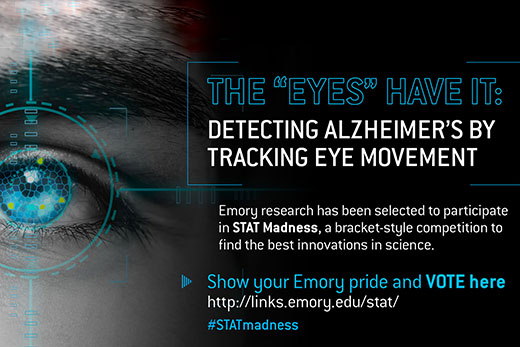Emory is participating in STAT Madness, a “March Madness” style bracket competition featuring biomedical research instead of basketball teams. Universities or research institutes nominate their champions, research papers that were published the previous year. It's like "Battle of the Bands." Whoever gets the loudest cheers — or most numerous clicks — wins.
The original lineup included 64 entries, with the competition starting March 2. After Emory beat out Gladstone Institute and advanced to Round 2, there are 32. Emory is now competing against the Koch Institute for Integrative Cancer Research at MIT (Massachusetts Institute of Technology).
Please vote here:
https://links.emory.edu/stat/
On the afternoon of March 10, Emory was just a few percentage points behind MIT (49% to 51%). Not everyone votes on every part of the bracket, so your vote can make a difference. In other words, you don’t have to fill out a whole bracket — you can just vote for Emory.
According to STAT:
The bracket will let you vote on your institution multiple times, you just have to wait a couple of hours in between votes.
If you feel like it, please share on social media using the hashtag #statmadness. STAT News is a Boston-based news organization covering biomedical research, pharma and biotech.
Emory's entry for 2020 is: Detecting Alzheimer’s and MCI by eye tracking
Currently, when someone is evaluated for memory loss, they get a battery of “paper and pencil” tests to assess their verbal memory. Emory Brain Health Center researchers have developed an alternative that may be less frustrating for those taking the test and less cumbersome for those administering it.
It’s a platform for evaluating visual memory, by tracking eye movements while someone views a series of photos. The regions of the brain that drive visual memory formation, such as the entorhinal cortex and hippocampus, are some of the earliest to deteriorate in MCI (mild cognitive impairment) or Alzheimer’s.
When someone views a photo twice, and the photo has been changed the second time, people with MCI or Alzheimer’s spend less time checking the new or missing element in the photo, compared with healthy controls. The entire test takes a few minutes on a standard computer monitor.
The study was published in Learning and Memory in 2019. The 296 study participants came from the Emory Healthy Aging Study and the Goizueta Alzheimer’s Disease Research Center — in all cases, people who had detailed clinical evaluations.
"We think this could be a sensitive yet specific method for detecting visual memory impairment, and it's convenient enough for use on a wider scale," says neurology chair and ADRC director Allan Levey, who is senior author of the paper. "So far, we've seen that the eye-tracking approach can be less frustrating for both patients and research participants."
First author Rafi Haque is a MD/PhD student in the Neuroscience program, with bioinformatics chair Gari Clifford as a co-author. A forthcoming follow-up publication deals with the challenge of using the built-in camera on an iPad, instead of an external infrared eye-tracker.

